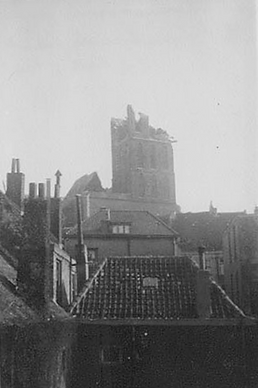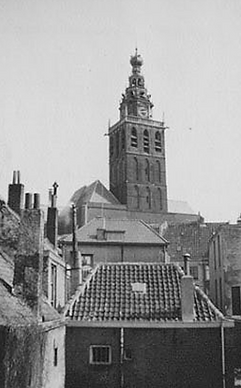Nijmegen during the Second World War
Most British people who attend the Four Day Marches are aware of Nijmegen’s part in Operation Market Garden, even if it only having seen the film ‘A Bridge Too Far’. Many also know about the city’s role in the front line until early 1945. Little has however been written in English relating to Nijmegen’s experience of war prior to September 1944. While not a comprehensive history, this page attempts to summarise some episodes of Nijmegen’s war history prior to its liberation by US Airborne and British Army troops.
German Invasion May 1940
The Dutch armed forces mobilised in September 1939. It was hoped this would help deter invasion, as it did in 1914. If an attack did come, it was accepted that Dutch forces could not stop the inevitably stronger Germans. They could however slow any advance and, if the larger French and British forces were successful further south, there was a chance that any invasion would stall. This did not, of course, happen.
The Wehrmacht were aware that Dutch engineers had mined all key bridges within easy reach of the border, including the road and rail bridges at Nijmegen. As the River Waal was a formidable natural defence, a decision was made to try to capture these bridges intact by taking the sentries by surprise. A plan to use a civilian barge to tow a 100 man raiding party downstream the night before the invasion was abandoned due to the presence of a Dutch Navy gunboat upstream close to the border. Instead, a Waffen-SS motor-bike reconnaissance unit, reinforced with armoured cars, were assigned the task of passing through Dutch defences south of the Waal as soon as hostilities commenced, drive the 6 km to Nijmegen at top speed and seize both bridges.
At dawn on 10 May 1940 German forces invaded the Netherlands at the same time as their attacks on France, Belgium and Luxembourg. The SS reconnaissance unit advanced to Nijmegen as planned, only to witness both bridges being blown as they arrived. Dutch forces south of the Waal soon withdrew westward to prepared positions along the Maas-Waal canal. Nijmegen was the first Netherlands city to fall and saw no more substantive fighting during the 1940 campaign.
By destroying the Nijmegen bridges, the Dutch Army not only prevented German forces south of the Waal from joining up with others further north, but also effectively blocked the river, denying the river route to the invaders.
The Waal ferry, closed when the road bridge opened in 1936, recommenced shortly after the end of hostilities. Dredging under the north span of the road bridge allowed limited river traffic, while the fallen central arch was repaired. The road bridge was finally re-opened in 1943.

It is possible that one reason the SS were slow in attempting to blow the bridge in September 1944 was the knowledge that Germany had provided the resources to re-build it, a major task given the shortages of wartime!
Among Nijmegen City forces in 1940 were the Burger Wacht. This was a part time citizen force mobilised in national emergencies such as civil disorder and foreign invasion. All main Dutch cities had a local unit, many commemorating their role in 1940 with the award of a special medal. Apart from a policing role, the Burger Wacht saw little action in Nijmegen, the 1940 campaign in the city being over by mid Morning on the 10 May.
.jpg)
LEFT: Prior to May 1940, the Dutch Army built a bullet proof barrier at the south end of the bridge. This was to be used to slow up a German advance in the event a failure to blow up the bridge.
The Bridge in 1940
.png)
.png)
.png)
ABOVE and RIGHT: The Nijmegen road bridge after it had been blown by Dutch Army Engineers on the morning of 10 May 1940.
LEFT: The Nijmegen rail bridge was blown by the Dutch Army on the same morning.
RIGHT: The Bridge under repair. The central arch is being straightened and restored on site before being raised up to its original position. This photograph was taken in 1942.
.png)
.png)
.png)
.png)
ABOVE: In late February 1942 the river Waal froze over. People could walk from Lent to Nijmegen without the need of either a ferry or a bridge!
The picture on the right shows the central arch of the Waalbrug still in a lowered position during its repair.
Nijmegen’s Jewish Community
In 1940 the City's Jewish community numbered about 530, Jews having lived in Nijmegen since the 1300’s. Once the German occupation was established in the Netherlands the rights of Jews gradually reduced. In November 1940 all were expelled from public positions, including in universities, schools and the civil service. In January 1941 they had to register with the authorities. In September 1941 Nijmegen's Jews established their own school when Jewish children were excluded from state schools. The wearing of a yellow star was required from May 1942.
The deportation of Nijmegen’s Jews commenced in September 1942, and was completed in April 1943. Most deportees went to Westerbork camp within the Netherlands before being sent on to Sobibor or Auschwitz in Poland. Of the Jews deported from Nijmegen, nearly 400 perished. In 1951 the city had a recorded Jewish population of only 52.
On 22 February 1944 the old synagogue in Nonnenstraat, (attended by Karl Marx's mother a century and a half before), was damaged by the US air raid. It has since been restored and is used for services.
.jpg)
.jpg)
ABOVE: The synagogue on Gerard Noodtstraat was opened in 1913, and is on the day one Vierdaagse route.
LEFT: Confiscated by the Germans in 1941, the building was looted and defaced with anti Semitic slogans by members of the Dutch NSB (Nationaal Socialistische Beweging) and used as a warehouse.
RIGHT: After the war it was sold by the Jewish community and used as a Nature Museum until 2017. It is now a gym.
RIGHT: The Jewish cemetery opened in 1891. It is on the day three Vierdaagse route, about two kilometres from the end. Following the route, it is on the right hand side, about 150 metres before marchers pass in front of the imposing gate of the main Kwakkenberg Cemetery.
The Air Raid of 22 February 1944
.jpg)
In the early afternoon of Tuesday 22 February 1944, Nijmegen was heavily bombed by planes of the American 8th Army Air Force. The resultant fires took until noon the next day to bring under control. Massive damage was done to the historic City centre. Nearly 800 Dutch civilians were killed and over 1,200 buildings were either destroyed or badly damaged. The railway station and a primary school received direct hits.
The bombing was a mistake caused by poor navigation. When low cloud led to their mission to bomb industrial targets in Germany being abandoned, the aircrews selected what they took to be another German target. They may have thought they were over the German city of Kleve 20 kilometres to the east.
The German military authorities in Nijmegen claimed that the bombing was a deliberate act by the allies. They produced posters telling the Dutch ‘Now you know who your true friends are!’ and attended the mass funeral of those killed. However, the occupation had become increasingly oppressive and this campaign had little effect. When American soldiers arrived seven months later, they were warmly welcomed as liberators.
Post war research by Dutch historians has found no evidence that Nijmegen was the deliberate target of the raid.
This newsreel filmed at the end of the war shows the extent of the damage caused by the February 1944 air raid:
.png)
ABOVE: The view from Lent minutes after the air raid.
RIGHT: The tower of St Stephens Church, before and after the raid. The main body of the church survived with little damage.
.png)
.png)

LEFT: After the fires were extinguished. This shows the massive damage inflicted to the north eastern part of the City centre.
The Marches during the 1940-44 War
A HIstory of the Marches during the war is at:

